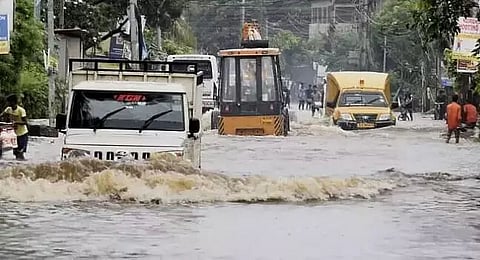
- Home
- Live Blog
- Breaking News
- Top Headlines
- Cities
- NE News
- Sentinel Media
- Sports
- Education
- Jobs

STAFF REPORTER
GUWAHATI: As the first pre-monsoon showers hit Guwahati, the city found itself submerged in a familiar crisis—water logging, clogged drains, and unsanitary conditions—casting serious doubts over the much-publicized “Mission Flood-Free Guwahati” campaign.
Despite promises by the Guwahati Municipal Corporation (GMC) and the Public Works Department (PWD) to make the city flood-resilient, ground realities paint a starkly different picture. “There is no new strategy. We are still doing everything manually. Culverts are clogged, and it’s very difficult to clear them,” admitted a GMC source. While arterial roads occasionally see super sucker machines at work, most desilting in interior lanes remains a laborious, manual process—slow, hazardous, and ineffective. Residents of areas like Wireless, Hatigaon, Ajanta Path and Rajgarh have reported heaps of silt left unattended for days, breeding mosquitoes and worsening public health risks. “Every year it’s the same story. They dig up the drains and leave the muck all around,” said a frustrated Hatigoan resident. The Standard Operating Procedures (SOPs) issued in February 2025 for desilting drains, aimed at ensuring swift clearance and accountability, have been largely ignored. The SOP mandates same-day silt clearance, use of leak-proof vehicles, geo-tagged photographic documentation, and monitoring by Urban Technical Officers. However, field inspections reveal rampant violations. No geo-tagging, no proper supervision, and no swift removal of waste have become the norm. Further complicating matters is the fragmented drainage management spread across three agencies—GMC, PWD, and the Guwahati Metropolitan Development Authority (GMDA)—leading to buck-passing and a lack of ownership.
Also read: Assam CM “Mission Flood Free” Drive to Tackle Urban Flooding in Guwahati
Also Watch: